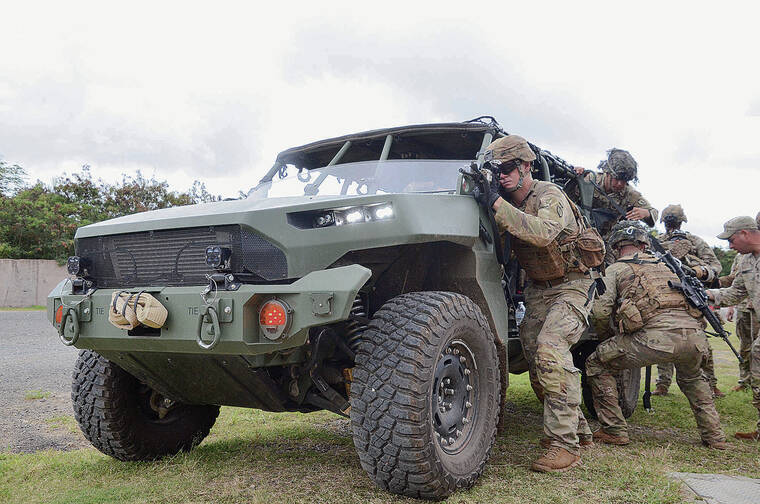
Mahalo for supporting Honolulu Star-Advertiser. Enjoy this free story!
Soldiers with the Schofield Barracks-based 25th Infantry Division are testing out a new lightweight hybrid vehicle this week as the Army rethinks how it operates in the Pacific.
The new Infantry Squad Vehicle, or ISV, carries nine soldiers and runs on a hybrid engine. It’s a far cry from the heavily armored vehicles the Army has utilized over the past 20 years as it contended with roadside bombs during operations in Iraq and Afghanistan.
Designed by General Motors’ defense division, the ISV is both fast and agile, and its hybrid engine is quieter than the diesel-powered vehicles soldiers often rely on. The vehicle is currently in use by the Army’s 82nd Airborne Division. The 25th Infantry Division is test- driving a vehicle on loan from GM Defense.
GM Defense representatives were in Hawaii this week for the Association of the U.S. Army’s LANPAC 2022 conference in Waikiki.“On the modern battlefield, mobility equals survivability,” said GM Defense President Stephen duMont. “It’s light enough to be swing-loaded under a Black Hawk helicopter, and it’s small enough to fit inside of a CH-47 Chinook.”
The 25th Infantry Division at Schofield Barracks gave up the last of its Stryker fighting vehicles in 2015 as the Army began divesting from the vehicles. Since then it has relied on aging Humvees, a nearly 40-year-old system the Pentagon says it intends to replace.
Capt. Douglas Taylor of the scout squadron of the 25th Infantry Division’s 3rd Brigade led troops testing the ISV while they trained at Marine Corps Training Area Bellows. “I think it’s a pretty awesome new system, to be honest — to the point where I wish I had one of these, at least where I was in Afghanistan,” Taylor said.
He noted that it can be difficult for soldiers to move quickly and gauge “situational awareness” of what’s happening outside of a vehicle in the more heavily armored types of transport. Even so, the ISV has been a controversial program.
A Pentagon report released in January found that while the ISV “is operationally effective for employment as a troop carrier and can accomplish air assault missions in a permission environment,” the vehicle “is not operationally effective for employment in combat and engagement, security cooperation and deterrence missions against a near-peer threat.”
The report said that during training missions the ISV was unable to fight back or avoid enemy detection, ambushes and engagements “during a majority of their missions.”
But both the Army and GM Defense insist that the ISV was never meant to serve as as a combat vehicle, arguing it’s designed to move soldiers quickly into place and that they would leave the vehicle so that they can maneuver and fight on foot.
Taylor said that for his scouts, who try to avoid direct combat altogether whenever possible, the ISV is a good fit. “For us, I think it has a lot of decent use cases for the reconnaissance mission that we would have” related to any potential conflict in the Pacific, said Taylor.
He noted that for his troops it much better suits their mission than wide, heavy Humvees, which are difficult to move in and out of the sorts of areas in which they would have to operate. In the Pacific, he said, “there’s a lot of very weird airfields — very small airfields, very limited access.”
Taylor also pointed out that in the current fighting in Ukraine, heavily armored Russian tank columns have been decimated by Ukrainian infantry armed with anti-armor weapons that have been able to outmaneuver the invading forces.
The ISV was designed to be easy to use and easy to repair, and was built largely with commercially available parts. “It’s 90% based on the Chevy Colorado, so any soldier who’s driven the truck before, he’s gonna get in and look and see, you know, a vehicle on the inside that looks just like what they’ve driven in the civilian world,” said duMont.
A major selling point of ISV is its hybrid engine, which GM Defense hopes will ultimately rely more on electric power than petroleum fuel. The U.S. military is one of the world’s largest users of fossil fuels. Its greenhouse gas emissions output eclipses some entire countries’.
During an Earth Day speech in Seattle, President Joe Biden said, “We’re going to start the process where every vehicle in the United States military, every vehicle, is going to be climate-friendly — every vehicle. I mean it.”
The military has had a keen interest in renewable energy sources for years, but for practical reasons more than environmental ones. “The reason why the Army has been exploring hybrids and the reason why we’re working with them to continue to use that technology is more about recharging,” said duMont.
The military hopes using renewable energy can free forces from the “tether of fuel,” stepping up ability to continue operations if supply lines are cut during battle. Also, Taylor said, quiet electric engines could provide significant advantages for troops like his scouts. He also said the odor of diesel exhaust can also tip off the enemy to their presence.
Beside the Army, GM Defense is eyeing the Marine Corps in the Pacific as a potential ISV customer, said GM Defense Vice President Pete Johnson, a retired Army general who formerly commanded U.S. Army Pacific at Fort Shafter.
The Marine Corps is in the midst of an ambitious restructuring of its forces, starting in Hawaii. In March it activated the 3rd Marine Littoral Regiment in Kaneohe at Marine Corps Base Hawaii.
The unit, which is set to serve as a blueprint for the service’s reorganization, focuses on island and coastal operations with a major emphasis on setting up missile batteries to help the Navy fight enemy ships.
“They’re going to be a long way from traditional lines of communication,” said Johnson. “They’re going to be out there, in some cases, on islands … sort of isolated from traditional support.”
Source: Star Ads





